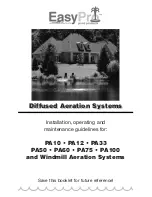
time. In this case, run the pump for
a few hours before checking for tight
spots. If there is suspicion of dam-
age, remove the pump from service
and disassemble for inspection.
5. Pump not fully broken in —
It is normal for new pumps to con-
sume higher than normal current
during the break-in period. If high
power consumption persists beyond
a few weeks, it is unlikely that further
operation will reduce consumption.
6. Pump not properly adjusted —
Loosen all nuts on pump exactly
exactly
one turn. Follow the instructions in
Section 5E Testing and Final Adjust-
ments for repositioning fasteners.
6F Pump Vibrates or Is Noisy
1. Insecure mounting —
Follow instructions in Section 2.
2. Piping load on pump —
Install piping supports and check
to see that there is no strain on the
pump.
3. Mechanical damage —
If mechanical damage is suspected,
check fi rst to determine if pump
turns freely. Disassemble for in-
spection if tight spots are found.
4. Pump has a high pitched whine —
This is typical of a regenerative
turbine pump. The intensity should
increase as pressure increases.
Over a period of a few weeks the
noise level will diminish and will be
noticeably quieter as it approaches a
run-in condition.
6G Mechanical Problems
1. Short bearing life —
Bearings damaged due to leaky
seals. Coupling misalignment. Pip-
ing load on pump. RPM or pressure
too high.
2. Pump locked up —
Pump dried out and close clear-
ances rusty. Follow installation
instructions for loosening the pump.
Foreign material in pump. Flush out.
Disassemble if fl ushing is not suc-
cessful.
3. Pump leaks —
Seal or “O” rings are usually the
problem. Disassembly and replace-
ment is the solution if tightening the
through bolts has no effect.
6H Seal Leakage
1. Worn seat or rotating element —
Seals will last many years operating
on cold clear water or other fl uids
with reasonable lubricity. Particles,
even microscopic, increase normal
wear rates. Temperatures near
the fl uid's boiling point can reduce
lubricity which in turn increases
wear. Some chemicals will erode
the seal faces or plate out on the
faces producing an abrasive effect.
Immediate seal replacement is
recommended when leaks become
evident, since bearings are quickly
ruined as a result of moisture.
Severe mechanical damage results
when the bearings fail.
2. Improperly installed seat or rotating
element —
If a seal has recently been replaced,
look for a missing “O” ring around
the seat, or a seat that is cocked or
in backwards. The smooth surface
should face the rotating element.
The rotating element may be in
backward or improperly positioned.
Refer to the appropriate seal dia-
grams and instructions to confi rm
the correct seal orientation. Rotat-
ing elements sometimes stick in the
wrong position if left partially as-
sembled for some time. Make sure
a rotating element can be moved
axially on the shaft before closing up
the pump and then make the fi nal
adjustments as soon as possible.
3. Seat broken during assembly—
Ceramic seats are particularly vul-
nerable to damage.
Carefully follow reassembly instruc-
tions for seals.
4. Pitted shaft under the seal —
Reusing a shaft when repairing a
pump is the probable cause of this
problem. The seal rotating element
can produce a pitted surface under-
neath its elastomer portion during
normal use. This is normally not a
problem for the fi rst seal assembly
since the elastomer is conforming as
this action occurs. A new seal can
leak before it conforms if the pits are
large enough. If any pits are visible
to the unaided eye, shaft replace-
ment is advised.
Page 515


































